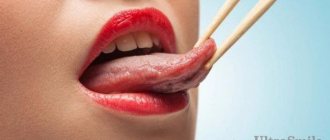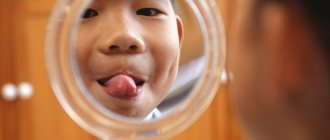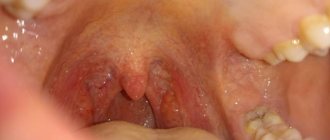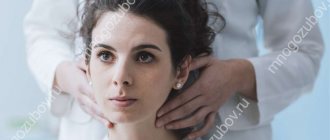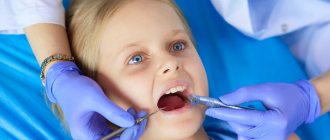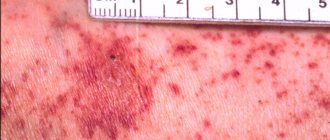21.12.2019
Any area of the oral cavity is susceptible to inflammatory and non-inflammatory diseases. Because the roof of your mouth can hurt for a variety of reasons, there are many treatment options available.
What is the palate and where is it located in the oral cavity?
As mentioned above, this is a horizontally located partition that separates the oral cavity from the nasal cavity. Approximately 2/3 of its surface suggests the presence of a bone base. These are solid processes in the form of plates that have a concave shape and are located in a horizontal position on the upper jaw. They are covered by a thin mucous membrane, which turns into the velum palatine. This is already a muscular formation with a fibrous membrane, also covered with mucous membrane.
The upper palate is the wall located in the mouth from above in the horizontal plane
It is the soft part that represents the barrier between the mouth and pharynx, and on its far edge there is the uvula. The palate is directly involved in the process of chewing food and swallowing, helps in the reproduction of sounds, which makes it an important component of the articulatory apparatus.
Reasons for the development of the inflammatory process
Inflammation of the palate near the tooth can occur:
- due to mechanical damage when eating crackers, seeds, nuts and other solid foods,
- thermal burn,
- some diseases - candidiasis, stomatitis,
- frequent smoking,
- pathologies of the jaw joints,
- inaccurate tooth extraction, violation of the rules for installing a microprosthesis.
Inflammation can develop under the influence of one or more factors. The problem cannot be ignored, as this can lead to blood poisoning, problems with breathing and swallowing.
Causes and symptoms of inflammation
At the initial stage of the pathological process, primary inflammation is diagnosed. First, blood circulation in the tissues is disrupted, and the person begins to experience moderate discomfort or even pain, which is especially noticeable when touching the palate with the tongue. Slight swelling appears. When the problem enters the stage of secondary inflammation, the pathological process takes over more space, and the pain noticeably intensifies. When the upper palate hurts, there can be a variety of reasons. Let us consider the main prerequisites in more detail.
Infections in the mouth
Infections of a bacterial and fungal nature (candidiasis) can provoke inflammatory processes, including on the mucous membrane of the palate. With this clinical picture, a whitish coating usually appears, painful ulcers, red areas and swelling may appear. If the problem is not addressed in time, the burning and pain will intensify, which will subsequently create serious difficulties in chewing food and swallowing.
The photo shows candidiasis in the mouth
Mechanical, thermal and chemical injuries to the mucous membrane
The palate is easily scratched by hard foods, such as seed shells or crackers. The problem may also be the appearance of a thermal or chemical burn after eating too hot food/drinks or sour, salty, spicy foods. Such microtraumas in conditions of insufficient hygiene become a favorable aid for the formation of pathogenic microflora and infection of tissues. The result will be redness and soreness. The mucous membrane usually swells, ulcers and blisters appear.
Dental diseases
Pathologies such as caries, pulpitis and stomatitis can also lead to the appearance of painful ulcers on the palate and along the entire perimeter of the mucous membrane. The inflammatory process often spreads to the surrounding soft tissues, including the palate and tongue, causing corresponding complications. A similar clinical picture also occurs with severe periodontitis or periodontal disease.
Another possible problem is leukoplakia, the development of which is accompanied by the formation of compactions in the mucous membrane and the appearance of dense whitish plaques, which can also be localized in the palate. The cause of this pathological phenomenon may be trauma, frequent rough mechanical impact on the mucous membrane, excessive smoking and consumption of low-quality alcohol.
The photo shows leukoplakia
Other Possible Prerequisites
In some cases, symptoms of inflammation appear after the installation of metal crowns or braces. Here, the appearance of redness, itching, and swelling can be provoked by the influence of galvanic currents and a corresponding change in the natural environment in the oral cavity. The reason why the soft palate in the mouth hurts may be associated with infectious diseases of the ENT organs.
It should also be noted that adult heavy smokers and those who abuse low-quality alcohol are especially susceptible to frequent dental problems. It also happens that inflammation of the palate is caused by disturbances in the functioning of the submandibular, sublingual and minor salivary glands. Sometimes, as a result of such disorders, various neoplasms arise in the oral cavity - from small benign to serious malignant tumors, including fibromas, papillomas, lymphangiomas and other painful phenomena. In any case, if you suspect a problem, you should definitely contact a specialist.
Diseases of the ENT organs can cause this symptom
The main signs of inflammation of the palate
Some symptoms of inflammation can reveal its nature. The color of inflamed tissue can tell a lot. Redness accompanied by enlarged tonsils indicates the presence of tonsillitis. Bubbles filled with clear exudate indicate herpes. Red ulcers covered with a white cheesy coating indicate a fungal infection.
Infectious diseases are almost always accompanied by unpleasant sensations - the palate hurts, swells, bleeds and burns when swallowing. Often, not only the palatine bridge on top swells, but also the tongue, which leads to increased salivation and problems with swallowing. As a result, irritation of the larynx and throat may begin, in which a burning sensation is felt, ulcers appear, pain and swelling occur. It becomes extremely painful to swallow food. Sometimes the gums begin to bleed, and in rare situations the body temperature rises.
The nature of the pain and the need to contact a specialist
If the roof of your mouth hurts, the nature of the course of this symptom usually depends on the cause that led to the inflammatory process. To understand what exactly caused this reaction, you will have to seek medical help. If this is simple damage from rough food, the wound may swell for several days, but the sensations will be tolerable, and the discomfort should gradually subside.
To speed up the healing process, experts recommend being careful when eating and rinsing your mouth with a light antiseptic solution or a soothing herbal infusion. You should consult your doctor personally about suitable medications for symptomatic therapy.
If the pain does not go away within 3-4 days and only gets worse, you should definitely visit a dentist. If the situation is ambiguous, the specialist will suggest undergoing a diagnostic examination. To determine the cause of the pathological process, you may have to undergo x-ray diagnostics, as well as visit other specialized doctors, for example, an ENT specialist, an infectious disease specialist, a therapist or an oncologist.
The palate and tongue hurt: when is a visit to the doctor important?
There are cases when the palate can be damaged as a result of chewing solid food or pricking the mucous membrane on a fish bone. In such cases, seeing a doctor is not necessary. To eliminate discomfort and minimize the likelihood of inflammation, you can rinse your mouth with herbal decoctions, such as chamomile or calendula.
Often, soreness of the palate and tongue is caused by burns from hot food. This combination of circumstances is not a necessary reason for visiting a doctor; Over time, the mucous membrane will heal on its own. A chemical burn of oral tissue is a reason to contact a specialist as soon as possible; you may need treatment in a hospital.
Important ! Self-medication for pain in the palate is dangerous. Painful sensations can be eliminated only after prescribing the main treatment.
All the diseases listed above cause pain in the palate, but you should remember that it can only be relieved in conjunction with the main treatment. It is not enough to know the symptoms of the disease; you need to understand the nature of its occurrence. It is not possible to independently determine what medications you will need.
Inflammatory processes developing in the nasopharynx call for treatment with antibiotics, and their independent administration is strictly contraindicated. Pain with tonsillitis and tonsillitis are similar, but the treatment is different.
Soreness in the palate, not accompanied by other symptoms of inflammation, initially requires a visit to the dentist. Based on the results of the examination, he will make a conclusion about treatment or refer you to another specialist - an oncologist, otolaryngologist or infectious disease specialist.
How is differential diagnosis performed?
As mentioned above, if the doctor has doubts about the cause of the symptoms, the patient will have to undergo a differential diagnosis. It is necessary to make a correct diagnosis, excluding all other pathologies with similar symptoms. As part of such a survey, the following activities may be required:
- visual examination and medical history,
- x-ray examination,
- general blood tests and allergy tests,
- consultation of specialized specialists,
- full examination of the body, including ultrasound and CT.
For diagnosis, it is necessary to undergo tests.
But such in-depth diagnostics are not needed in all cases. If the clinical picture is obvious, the doctor will not require additional procedures. However, it is very important to establish an accurate diagnosis, because the further course of treatment will directly depend on it.
Symptoms associated with palate pain, ways to eliminate it
Any disease has its own specific symptoms. The doctor must be able to navigate the signs of pathologies in order to correctly make a diagnosis. The patient, in turn, would also do well to study the manifestations of a particular disease in order to determine the specialist who needs to visit.
Ulcers that appear in the mucosal area are a symptom of a disease called candidiasis (thrush). Aphthae cause unpleasant and even painful sensations to a person, and itching often occurs. The disease can be identified by a cheesy coating that can “populate” the entire surface of the tongue. To treat candidiasis, it is necessary to take antibiotics and rinse the mucous membranes with antiseptics.
Sore throat has the following symptoms: hyperemia of the palate, swelling, inflammatory processes in the tonsils and, as a result, their enlargement. Body temperature can rise quite strongly, and the process of swallowing food causes pain. There are many forms of sore throat: these include catarrhal and follicular. In order for the treatment of sore throat to be effective, it is mandatory to take antibacterial drugs; To avoid complications, the course of treatment should last at least 10 days.
It is possible to get diseased teeth and palate as a result of diseases such as pulpitis and periodontitis. Symptoms manifest through severe pain of a throbbing type, which causes a lot of problems to the person. Pain occurs due to inflammation of the pulp - a bundle of nerves. The treatment is carried out by a dentist - he prepares the diseased tooth, rinses the canals and performs filling.
Important ! It may additionally require removal of tartar, rinsing of the gums and antibiotic therapy.
As a result of tooth extraction, pain in the vault of the palate, swelling and erythema of the gums also sometimes occur; alveolitis is often to blame. The disease is an accumulation of pus on the walls of the socket, where the previously extracted tooth was. Complications of subsequent removal may occur due to poor treatment with antiseptic agents, loss of a blood clot from the socket, or due to weak immunity. Alveolitis can be assumed by swelling of the face and gums, and elevated body temperature. Therapy consists of cleaning the hole, taking antibiotics and treating the damaged area with antiseptic solutions.
A gray coating on the cheeks and roof of the mouth, swelling is observed with leukoplakia. A burning sensation is felt in the oral cavity, saliva production decreases, and thirst is noted. There is a slight soreness in the palate, the mucous surface is tightened and has a rough structure. This condition is often sluggish and lasts a long time. Plaque is replaced by keratinization of areas. They have a white coating on them, which can be scraped off without difficulty. Treatment of the disease includes taking vitamin complexes and immunostimulating substances. The possibility of complications leading to oncological forms of the disease cannot be ruled out.
A tumor located in the oral cavity and is benign does not cause pain in the palate. Such formations do not cause inconvenience to humans, and their detection is a matter of chance.
Must be remembered ! Determining the type of tumor and deciding whether to remove it is the doctor’s task.
There are many ways to remove tumors that are minimally traumatic for the patient. These include: electrocoagulation, laser removal, radio wave removal, sclerotherapy, removal using liquid nitrogen.
When there is a pathological condition of the maxillofacial joint, pain may also occur. As a result, after inflammatory processes of bone tissue in the palate, severe pain occurs, which intensifies when chewing food or when opening the mouth. There may be redness and swelling of the soft tissues, a feeling of fullness in the joint, and an increase in body temperature. Treatment prescribed by a doctor is symptomatic.
You should immediately visit a doctor if the following symptoms appear:
- decreased taste sensitivity;
- pain occurs when swallowing and chewing food;
- there is a sensation of a foreign body in the oral cavity;
- mucous tissues are swollen;
- teeth began to crumble;
- inflammation and soreness appeared in the gum area;
- the appearance of ulcers and seals in the palate.
What to do if your palate hurts. Treatment methods
First of all, it is necessary to treat exactly what served as the impetus for the development of the pathological process. As part of supportive symptomatic therapy, special solutions for oral baths and mouth rinses are usually prescribed. These may be antibacterial, anti-inflammatory or antifungal agents, depending on the nature of the problem.
Gels and ointments are also often prescribed for external use, with a similar therapeutic effect or, for example, antihistamine action, if swelling, redness and itching are an allergic reaction. If a serious infection occurs, your doctor may prescribe antibiotics. It is important to remember that only a professional doctor can select adequate treatment in your particular case.
Various gels may be prescribed for treatment
Leukoplakia
Unlike stomatitis, leukoplakia does not cause any discomfort. One or more white spots simply appear on the tongue or the inside of the cheeks. Moreover, they can look different. These may be flat spots with smooth edges and a smooth surface. Or uneven, ulcerated. Or not even spots, but bumps and not completely white, but red and white.
Most often, leukoplakia appears in older men who smoke a lot, abuse alcohol or chew tobacco. But it happens that there is no obvious reason for this condition - such a disease is called idiopathic.
Leukoplakia itself is benign.
But in 3-17% of cases it can degenerate into squamous cell carcinoma (one of the types of skin cancer). Therefore, a patient with it must be referred for a biopsy. This is a procedure in which a specialist takes pieces of altered tissue to then look under a microscope to see if they contain malignant cells. Depending on the situation, leukoplakia is treated with medications (special vitamin A derivatives) or surgery. Even after the stains are completely eliminated, the patient is asked to see the dentist more often - there is a risk that the disease (and with it the threat of cancer) will reappear.
What drugs are used in different clinical cases
The choice of treatment must be justified by the cause of the problem. So, all the drugs that are prescribed if the palate is inflamed or if the gums also hurt can be divided into 3 large groups:
- antifungal: these include broad-spectrum antimycotics that effectively combat the development of candidiasis and trichomonas. They are usually prescribed for trauma to the mucous membrane, for stomatitis and thrush - “Levorin”, “Nystatin”, “Candide”,
- antibacterial: these include antibiotics that specifically prevent the proliferation of bacteria and pathogenic microorganisms. So, for example, “Metronidozole” and “Amoxicillin” can only be prescribed by a doctor, and their help is usually resorted to when there is a serious infection of tissues and an increase in temperature. But antibacterial rinsing solutions are used as maintenance therapy, and these include “Chlorhexidine”, “Stomatofit” and others,
- antiviral - as a rule, used in the early stages of the disease and for preventive purposes, they suppress the reproduction of viruses. Such drugs include “Acyclovir”, “Oxolin”, “Interferon”1.
Drugs can only be prescribed by a doctor.
Any of the above drugs, and especially antibiotics, can only be taken as prescribed by a doctor. Remember, if suspicious symptoms appear, it is better to consult a doctor immediately. The longer you delay visiting a specialist, the higher your chances will be of encountering very serious consequences and complications.
Anatomy of the palate
The palate, located above, has two cavities - the oral and nasal. It includes two components - the hard and soft palate. The appearance of the upper palate resembles a dome.
There is a hard part of bone in front. The components are plate-shaped processes of the bone tissue of the upper jaw. From below, the palate is enveloped in mucous tissue, which in turn passes into the soft tissue of the palate, the so-called velum palatine. The location is very close to the tonsils, above the root of the tongue.
The soft palate is formed from muscles connected by connective tissue and mucous membrane. The cavity located behind the nose is divided into 2 entrances: into the laryngeal region and into the pharynx. The second entrance provides access to the trachea and esophagus.
Important ! With inflammation, pain affects both parts of the palate.
Discomfort is observed when speaking, swallowing food, and even at rest. For a person, these sensations are quite unpleasant. Where to go in such a situation? The first step is to consult a dentist. At the initial stage, he will determine the cause of the pain and refer you to the right specialist, or, if the case relates to his medical practice, prescribe the necessary treatment.
Video - More about the palate
Gels and ointments for treating inflamed mucous membranes
External agents, which include gels and ointments, are also prescribed to relieve pain and acute signs of inflammation. Below, as an example, are the most effective and popular drugs from this pharmacological group:
- “Nystatin” ointment - it is prescribed for candidiasis. The active ingredients in the composition destroy fungal cells and create a reliable barrier that prevents the further spread of infection,
- "Levomekol" ointment - has an antibacterial effect and promotes tissue regeneration processes. The active components of the product help reduce inflammation and actively fight the population of harmful microorganisms,
- “Solcoseryl” – this product contains an extract of calf’s blood (dialysate), which has a powerful therapeutic effect. The gel restores oxygen metabolism, triggers tissue regeneration processes at the cellular level and promotes collagen production, thereby accelerating damage processes,
- "Cholisal" is an anesthetic gel with a slight cooling effect. Helps relieve swelling and inflammation, destroys pathogenic microflora.
Gels and ointments are prescribed to relieve pain and acute signs of inflammation.
The choice of a suitable remedy remains at the discretion of the attending physician and directly depends on the cause of the development of the inflammatory process in the palate. Before use, you should carefully read the instructions and then follow all the instructions of the treating specialist.
Lichen planus
Lichen planus has many forms. One of them appears as white lacy spots in the mouth. Sometimes painful ulcers are added to these spots.
The disease occurs when the patient's own immune system begins to attack the cells of the mucous membranes and skin. Why this happens is unclear. But there is evidence that hepatitis C, certain chemicals, heavy metals and medications (for example, ibuprofen, naproxen or medications for the treatment of arthritis) can lead to malfunctions of the immune system.
Like leukoplakia, lichen planus is associated with an increased risk of oral cancer. Therefore, patients with it are also referred for a biopsy. Anti-inflammatory and immune drugs are prescribed for treatment.
A Brief Overview of Mouthwashes
Pharmacy rinses help relieve acute signs of inflammation, relieve pain and reduce swelling. Among the most effective drugs in this category, experts identify the following medications:
- Chlorhexidine is an inexpensive antimicrobial agent that helps to significantly reduce inflammation and stop the spread of infection. It is recommended to use for rinsing no more than 3 times a day,
- “Stomatofit” is a herbal remedy that helps with gingivitis and periodontitis,
- "Furacilin" - prescribed for inflammatory processes in the throat, palate and oral cavity. Has a pronounced antimicrobial effect and ensures the destruction of pathogenic microflora,
- “Chlorophyllipt” - a composition based on eucalyptus helps to soothe an irritated throat and palate during colds.
Pharmacy rinses help relieve acute signs of inflammation
“For some reason, my palate gets irritated about once every six months. I don't know, maybe it's too sensitive. And it happens that the pain is simply unbearable, you have to swallow painkillers. But in such cases, I usually rinse my mouth with chlorhexidine and after a week everything goes away completely.”
MariaS., from correspondence on the forum www.32top.ru
You should start using any of the drugs described above only after consulting a specialist. First, you should visit your dentist and determine the exact cause of the inflammation.
Prevention of infectious lesions of the upper palate
It is easier to prevent inflammation of the palate than to cure its advanced stage. To do this you need to do the following:
- Limit the intake of solid foods - crackers, caramel, chips, lollipops, cookies. They can accidentally scratch the oral mucosa.
- Wash vegetables and fruits thoroughly. By consuming dirty foods, you can introduce infection into wounds and scratches on the oral mucosa, which can lead to the development of inflammation.
- Eliminate excessively cold and hot foods from your diet so that they do not burn the soft tissues in your mouth. This rule must be followed if the palate is already inflamed.
- Stop drinking sweet soda, as it irritates the oral mucosa. Strong alcohol has the same effect.
- Brush your teeth regularly. Brushing your teeth twice a day will not only protect against caries, but also prevent bleeding gums and the appearance of swelling near the uvula. You should also rinse your mouth after every meal, especially if your palate is already swollen.
- Constantly strengthen your immune system. You need to exercise, eat natural foods, plan your diet wisely, ensure regular good sleep and monitor the replenishment of vitamins and microelements.
- Treat your teeth regularly. To make your teeth strong, it is not enough to brush them daily and eat right. In addition, you should visit the dentist 2 times a year to undergo preventive examinations, remove tartar and plaque, and promptly treat caries and gingivitis (gum inflammation).
- Consult a doctor for any symptoms of dental diseases and pathologies of the ENT organs: if the throat turns red, the tonsils become swollen, signs of inflammation begin to be felt, wounds, ulcers and swelling appear in the mouth, and pain occurs in the palate.
- Monitor the condition of children's teeth. This rule applies to parents. It is worth explaining to your child that you should not put your hands or dirty objects in your mouth. Explain why exactly you shouldn’t do this.
Every person should take care of their oral health. Maintaining immunity, proper nutrition, good hygiene and timely visits to the dentist will help completely eliminate the risk of developing diseases of the palate and the appearance of pain in this area. If the inflammatory process has already begun, you should urgently consult a doctor and follow all his treatment recommendations.
Category Miscellaneous Published by Mister dentist
What does traditional medicine offer?
Some remedies prepared from herbal ingredients based on folk recipes also help relieve inflammation and reduce pain in the palate. Tannins and astringents in their composition have a disinfectant and analgesic effect. The most popular and proven recipes are described below, but it is better to first discuss their use with your doctor.
Calendula tincture
Used for pharyngitis, laryngitis, tonsillitis and fungal infections in the oral cavity. To prepare the tincture, you can dissolve a teaspoon of the product in 200 ml of warm water. Or pour raw calendula flowers with a tablespoon of boiling water, strain and use for rinsing while warm.
Calendula tincture will relieve pain
Chamomile decoction
Soothes, relieves acute inflammation, helps with colds and fungal infections. A tablespoon of dried flowers is brewed in 200 ml of boiling water, allowed to cool, filtered and used for rinsing 3-4 times a day.
Chamomile decoction helps well in treatment
Sage based rinse solution
Recommended for laryngitis, as well as for scratches on the palate, pharynx or larynx. The solution perfectly relieves inflammation and relieves pain. Sage leaves and flowers (1-2 tablespoons) are brewed in 200 ml of boiled water. The product is infused until it cools completely, then filtered and then used for rinsing up to 6-7 times a day.
Oak bark decoction
Effectively relieves bleeding and inflammation, eliminates swelling. To prepare the solution, 2 tablespoons of crushed oak bark are diluted in 200 ml of water and heated in a water bath for 15-20 minutes. Remove, leave to brew for an hour, filter and then use for rinsing 4-5 times a day.
Gargling with a decoction of oak bark will help in treatment
Honey with tea or milk
Honey has an enveloping and soothing effect and effectively fights the proliferation of fungi and the spread of infection. To enhance the healing effects, it is recommended to eat honey with a warm drink or dilute it in tea.
You can relieve pain in the palate and reduce inflammation with the help of a medicinal mixture, for the preparation of which butter and honey should be mixed in equal proportions. The composition must cool completely, after which it can be taken 0.5-1 teaspoon 5-7 times a day.
Tea with honey is used to treat throat
Treatment
A differentiated diagnosis helps determine the treatment tactics for an inflamed palate. In an adult, microdamages of the palatum durum - the hard palate - heal most easily. Young children require more correct and long-term therapy. For antiseptic treatment of tissue and activation of healing of small wounds, the following drugs are recommended:
- Rotokan.
- solution .
- tincture diluted according to the scheme .
- Chlorhexidine.
- A solution of tincture of eucalyptus, calendula, chamomile.
Possible complications
Severe consequences of the pathological process are possible if you ignore obvious symptoms for too long and do not consult a specialist in time. The following manifestations become frequent accompaniments of inflammation of the palate mucosa:
- increased salivation,
- further spread of the lesion,
- the appearance of bad breath,
- bleeding gums,
- purulent processes.
In severe cases, the body temperature rises and there is a real risk of developing sepsis, that is, a general infection of the body. Such dangerous complications can result from tonsillitis, stomatitis, candidiasis or any other dental disease.
Therefore, if you experience pain in the oral cavity, you should immediately see a specialist. If it is a simple wound, the doctor will recommend suitable disinfectant, anti-inflammatory and wound-healing rinse solutions. If the reason is not so obvious, you will have to undergo a full examination and receive direct recommendations from a specialist.
1Lukinykh L.M. Diseases of the oral mucosa, 2000.
Complications due to neglect of symptoms
If the patient does not seek to treat the pathology, he runs the risk of treating a complicated form of his disease in the near future. The process will be significantly delayed and additional expenses will be required.
Infections caused by fungi, when swallowing contaminated saliva, enter the esophagus and affect internal organs. Treatment will be complicated.
A bacterial infection can enter organs and the brain through the blood, affecting their tissues.
Important! In severe cases, the infection can cause death.
Oncological diseases can be triggered by diseases of the oral cavity in a chronic form.
Herpetic stomatitis
Unlike aphthous stomatitis, herpetic stomatitis has a very specific cause. It is caused by the herpes virus type 1, which can be transmitted through kissing, dishes or shared towels. In the body of some people, the virus can live hidden all their lives, while in others it periodically announces itself with white bubbles on the face or oral mucosa. The last option is more typical for children.
Herpetic stomatitis is very painful and unpleasant, but, like aphthous stomatitis, it goes away on its own - within 2-4 weeks. For faster recovery, patients may be prescribed antiviral drugs. But they do not radically cure herpes, so in the future the disease may recur several times.
Rinse solutions
Proven pharmaceutical preparations can be used to treat swelling of the palate by rinsing the mouth. First of all, this concerns solutions:
- Furacilin to provide a reliable antiseptic effect. It is he who is able to completely eliminate inflammatory processes on the gums and mucous membrane, as well as neutralize pathogenic flora. The rinsing itself (1-2 tablets per glass of cooled boiled water) should be done every five hours. The general course of treatment lasts at least 8-10 days.
- Chlorhexidine is one of the most readily available antimicrobial agents, the use of which is limited to three procedures per day.
- Stomatofit was developed on the basis of extracts of medicinal herbs and is the most popular tool in the diagnosis of pathologies such as periodontitis and gingivitis (provoking swelling of the palate). The use of the drug is not recommended for children and pregnant patients, due to the presence of alcohol in the composition.
- Tantum Verde is a drug that is recommended to eliminate inflammation of the mucous membranes, gums and palate. The treatment course must last at least 10 days.
- Chlorophyllipt is distinguished by its composition of natural components (in particular, this applies to eucalyptus leaf extract), which promotes accelerated wound healing and the elimination of harmful flora.
Before you start using these medications, you must carefully study the instructions or consult your doctor in advance. This is especially true in cases of overdose and individual intolerance of the human body.
Remember
You should definitely see a dentist if there are stains in your mouth:
- do not last longer than 2-3 weeks,
- very painful, bleed,
- increase in size,
- accompanied by other symptoms (feeling of a lump in the throat, hoarseness, fever),
- changed color from white to red (this is a sign of infection),
- pass, then appear again.
Did you like the material? Put it? and subscribe. We write about how to keep your teeth healthy and what to do if problems arise.

